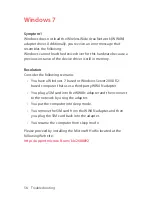
60 Glossary
•
GSM
— A computer program embedded in an electronic
device. Firmware usually contains operating code for the
device.
•
Hotspot
— A Wi-Fi (802.11) access point or the area covered
by an access point. Used for connecting to the Internet.
•
HTTP
— Hypertext Transfer Protocol. An application-level
protocol for accessing the World Wide Web over the Internet.
•
IP
— Internet Protocol. The mechanism by which packets are
routed between computers on a network.
•
IP Type
— The type of service provided over a network.
•
IP address
— Internet Protocol address. The address of a
device attached to an IP network (TCP/IP network).
•
Kbps
— Kilobits per second. The rate of data flow.
•
LAN
— Local Area Network. A type of network that lets a
group of computers, all in close proximity (such as inside an
office building), communicate with one another. It does not
use common carrier circuits though it can have gateways or
bridges to other public or private networks.
•
MAC Address
— Media Access Control. A number that
uniquely identifies each network hardware device. MAC
addresses are 12-digit hexadecimal numbers. This is also
known as the physical or hardware address.
•
Mbps
— Megabits per second.
•
Network Technology
— The technology on which a particular
network provider’s system is built; such as CDMA or EVDO.
•
Port
— A virtual data connection used by programs to
exchange data. It is the endpoint in a logical connection. The
port is specified by the port number.
















































